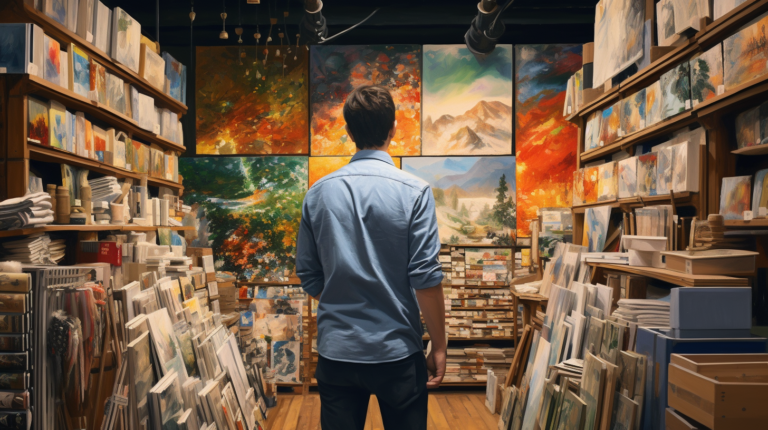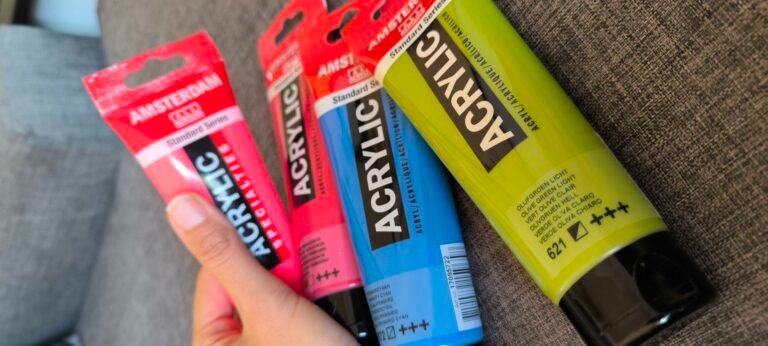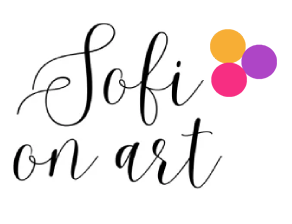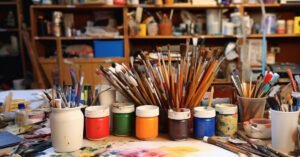If you’re like me, passionate about painting but also mindful of your budget, you’re in the right place. I’ve put together some smart and practical tips to help you save money as artist. (Also, don’t miss my comprehensive post about acrylic vs oil paints and how to get started with acrylics, in case you’re new here!)
These budgeting ideas are tailor-made and benefitial for all types of artists. So, let’s dive in and see how we can keep creating amazing art without breaking the bank.

Table of Contents
ToggleSave Money with Financial Planning and Budgeting
Plan and Prioritize Your Art Projects: It may seem that you need to buy everything at once, to get properly started. Very often, that’s actually not necessary. For example, if you’re planning a seascape, you might need various shades of blue and green, and maybe less of the warmer tones. Before purchasing, consider the scope of your projects, determining the colors and quantities needed to prevent buying unnecessary materials.
To save money as an artist, it’s wise to set a budget for your art supplies. For example, limit yourself to $50 for your next painting project. Carefully track every purchase, from new brushes to cheap acrylic paints. By keeping an eye on your spending, you can prioritize essential items like quality yellow ochre, while saving money on art supplies by avoiding non-essential luxury items, such as a gold leaf kit that you might not immediately need. This approach helps maintain your finances without compromising the quality of your artwork.
Use Coupons or Promotional Codes to Save Money as an Artist: Always be on the lookout for coupons and promotional codes in art magazines, newsletters, or websites specializing in art supplies, especially for cheap acrylic paints. For instance, you might find a 20% off coupon in a popular art magazine or a code for free shipping on an art supply website, helping you save money on art supplies.
Joining online artist communities or forums is also beneficial. These platforms often share information about current deals and exclusive promo codes, which are particularly useful for beginners in acrylic painting aiming to save money on their initial investments. By staying informed, you could find a great deal on that set of acrylics you’ve been eyeing, effectively managing your art budget.
Plan for Long-Term Investments: Consider setting aside a portion of your art budget for high-quality, durable tools that, while more expensive upfront, will offer better longevity and performance. For example, instead of repeatedly buying cheap brushes that quickly lose their bristles, save up for a set of high-grade synthetic brushes known for their durability and ability to hold paint well. These might cost more initially, but their extended lifespan means you won’t need to replace them as often, ultimately saving you money and enhancing your painting experience over time.

Shopping Strategies for Artists
Research and Compare Prices from Different Suppliers: Take the time to compare prices for specific items, such as a 200ml tube of titanium white oil paint. For instance, you might find it priced at $15 in a local art store, $12 on an online art supply website, and only $10 on a larger e-commerce platform during a sale. This comparison can lead to a direct saving of $5 per tube, which adds up significantly if you’re buying multiple tubes or other supplies. By routinely comparing prices across different suppliers, you can make more informed and cost-effective choices for your art supplies.
Take Advantage of Sales and Discounts: Watch for seasonal sales, clearance events, or special promotions, and sign up for newsletters from art supply stores for exclusive discounts. For example, many art supply stores offer significant discounts during back-to-school periods, usually in late summer or early autumn. Additionally, Black Friday and post-holiday clearance sales in late November and December are popular times for deep discounts on a wide range of art supplies.
Consider Buying in Bulk to Save Money as an Artist: Purchase larger quantities of commonly used items like cheap acrylic paints and share bulk orders with fellow artists. This strategy is effective for both acrylic painting beginners and experienced artists in managing art supply costs.
For example, if you frequently use white acrylic paint for mixing and underpainting, opt for a larger, economy-sized container, such as a gallon jug, instead of multiple smaller tubes. This can significantly save money on art supplies. Additionally, team up with fellow artists to buy high-quality stretched canvases in bulk. If a pack of 20 canvases costs $200, splitting the cost among four artists means each gets five canvases for only $50, which is cheaper than buying individually. This way, you get the benefits of bulk pricing without overstocking your studio.
Explore Alternative Brands or Student-Grade Supplies: To start with, opt for rather cheap acrylic paints and lesser-known brands, which can be more affordable yet still offer good quality.

Partner with Local Businesses for Supplies: Collaborate with local businesses for supplies, like off-cuts from carpenters or excess vinyl sheets from printing companies.
Here are a few more ideas for partnering with local businesses for art supplies:
Contact Local Printers: Local printing companies often have misprints or end-of-roll paper that can be perfect for sketching, painting, or mixed media art. You might get these at a very low cost or even for free.
Collaborate with Florists: Florists sometimes have interesting, visually appealing materials like textured papers, ribbons, and even dried flowers that can be incorporated into art projects.
- Explore Collaborations with Textile Businesses: Fabric off-cuts, threads, and other textile materials can be excellent for textile art or to add texture to your paintings.
Look for Art Materials That Can Be Used in Both Acrylic and Oil Painting: Seek out mediums and pigments that are compatible with both acrylics and oils for shared usage across projects. For instance:
Gesso: A common primer used to prepare canvases and surfaces. It’s compatible with both oil and acrylic paints, making it an essential and versatile base layer.
Mixed Media Paper or Canvas: High-quality mixed media paper or canvases are designed to handle both oil and acrylic, providing flexibility and durability for both mediums.
Palette Knives: These are great for mixing paints and applying textures. Since they don’t interact with the paint chemically, they can be used interchangeably with oils and acrylics.
Varnishes: Certain varnishes are formulated to be compatible with both oil and acrylic paintings. They protect the finished work and give it a uniform finish.
Pigments: Pure pigments can be mixed with different binders to create either oil or acrylic paints. Buying pigments in bulk and mixing your own paints can be a cost-effective and versatile approach. Related: check out my list of common colors and their pigment numbers here.
Brushes: High-quality synthetic brushes can be used with both acrylic and oil paints. However, it’s crucial to clean them thoroughly after each use to maintain their condition.
Mediums for Texture and Body: Some mediums, like modeling paste or gel mediums, can work with both types of paint to add texture or volume.
Tool and Material Management to Save Money as Artist
Take Care of Your Brushes and Tools to Extend Their Lifespan: Clean and store brushes properly to prevent frequent replacements and extend their life. Read here my post about how to clean your acrylic brushes.
Invest in Versatile Tools to Save Money on Art Tools: Opt for synthetic brushes that are suitable for both acrylics and oils, and choose palette knives that can be used for multiple techniques. This approach not only helps save money as an artist but also reduces the need to buy separate tools for different mediums. By selecting tools like these, which can handle a variety of tasks, you can work efficiently while keeping your tool expenses low.
Reuse and Repurpose Old Art Supplies: Paint over old artworks with gesso to reuse canvases and melt down small bits of dried paints to create new colors.
Exchange Skills and Supplies with Other Artists: Barter skills for surplus supplies and organize supply swap meets to trade unused items.
Innovative and Alternative Practices
Utilize Everyday Household Items: Use items like sponges, toothbrushes, or kitchen foil as tools for creating unique textures and effects.
Make Your Own Mediums and Grounds: Create mediums with household items (like white glue and water for acrylics) and prepare canvases with homemade gesso.
Harvest Natural Materials to Save Money on Art Supply: Explore your backyard or a local park to collect natural elements like leaves, twigs, or even soil. For example, gather different colored soils or clays to make a variety of earthy pigments. These can be ground and mixed with a medium to create unique, homemade paints.
Spices like turmeric for yellow or paprika for red can also add vibrant colors to your palette. Using natural materials not only personalizes your artwork but is also a sustainable and cost-effective approach. It allows you to experiment with new textures and hues while saving money as an artist.
This method, while seeming experimental, is a great way for artists to think creatively about their resources. It broadens the spectrum of materials that can be used in art, offering a fun and engaging way to connect with the environment and explore the potential of unconventional materials, without the need for expensive or cheap acrylic paints.
Implement Energy-Efficient Practices: Paint during daylight to reduce electricity usage and use energy-efficient LED bulbs in your workspace.
Community and Skill Development

Use Coupons or Promotional Codes When Available: Engage with artist communities to learn about and share promo codes and deals.
Exchange Skills and Supplies to Save Money as an Artist: Collaborate with other artists to exchange skills and supplies for mutual benefit. For example, if you’re good at building sturdy frames for canvases, and another artist excels in mixing custom paint colors, propose a barter. You could build a frame for their next painting, and they could mix a unique color palette for your project. This exchange fosters community among artists and helps save money on art tools and supplies, by gaining access to skills and materials otherwise unavailable.
Here’s a list of some of the best online art communities you can join to start exchanging skills and supplies (and there are many more!):
DeviantArt: A well-established platform with millions of users, offering a vast range of artwork in various mediums. It’s great for joining groups, participating in challenges, and receiving critiques from fellow artists.
ArtStation: Focused on professional artists and the entertainment industry, ArtStation showcases concept art, 3D models, illustrations, and digital paintings. It’s also a platform for building portfolios and discovering job opportunities.
Doodle Addicts: A unique community where artists celebrate the joy of doodling. It’s a place for sharing playful and imaginative creations and is welcoming to artists of all skill levels.
Reddit Art Communities: Subreddits like r/Art, r/DigitalArt, r/LearnArt, and r/ArtCrit offer spaces for sharing artwork, critiques, feedback, and discussion on various art mediums and practices.
Discord Art Communities: Servers like Art Club and Learning to Draw on Discord provide real-time communication, daily art prompts, creative challenges, and opportunities for feedback and critiques.
Educate Yourself with Free Online Resources: Utilize free online tutorials, courses, forums, and social media groups for learning and community support.
Space and Environment Optimization
Opt for Multi-Purpose Workspaces to Save Money as an Artist: Choose a painting space that can also serve other functions, utilizing dual-purpose furniture to cut down on the costs of specialized art furniture. Instead of a separate art studio, you might use a section of your bedroom or living room for painting.
For instance, a foldable desk can double as both a study table and a painting workspace. When it’s not being used for art, it can be easily folded away or used for other tasks like reading or working on your laptop. This method not only saves space but also helps save money on art supply expenses by reducing the need for dedicated art furniture. It’s an efficient solution for artists working in smaller spaces or with limited budgets.
To sum up, use these tips to save money as an artist. Focus on what’s essential: spending wisely, choosing affordable materials, and managing resources. This approach helps balance your budget without sacrificing your art’s quality. Stay creative, spend smart.




